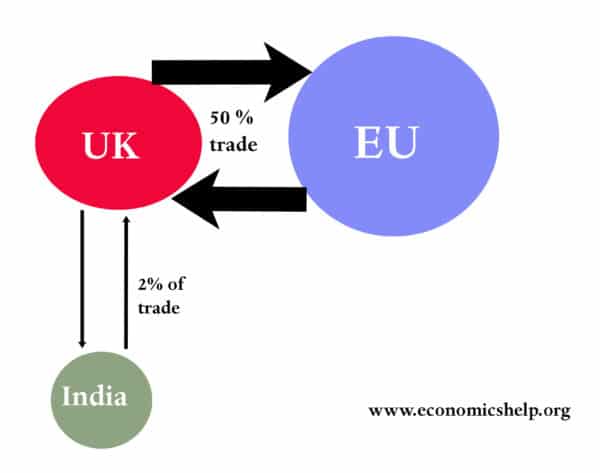In economics, gravity theory relates to how international trade between countries is influenced by
- Geographical proximity
- Economic size (mass) of the respective countries (M)
- Similarities in consumer preferences and economic development
The gravity theory of trade suggests, ceteris paribus, an economy will gravitate towards trading with its closest neighbours and economies which are similar in terms of size, cultural preferences and stage of development.
It is based on Newton’s law of gravity that there is gravitational pull of objects directly proportional to the mass of objects and inversely proportional to the distance between them.
The model was developed in the 1960s by Jan Tinbergen, a Dutch Nobel-Prize winner. Despite having a weak theoretical basis, its empirical results have been strong – with many studies showing countries have a tendency to trade in close economic blocks, such as the EU, South East Asia and North America.
However, it is only part of the trade equation, Ricardian comparative advantage and relative factor endowments still explain the trade between countries with little ‘gravitational pull’ e.g. import of raw materials, cheap manufacturing from across the world.
Some economists argue gravity theory is theoretically weak and globalisation will shirt patterns away from trading with close neighbours to a more global economy.
Factors in gravity theory that may determine bilateral trade
- Size of economies. Similarly sized economies are more likely to trade with each other
- Geographical proximity. Countries close together have lower transport costs, similar customs and familiarity. Geographical proximity is usually greatest for a shared border.
- Shared history, e.g. colonial links, explain post-war trade between UK and Commonwealth.
- Language similarities – This strengthens the bonds of trade. It is easier to communicate and there is likely to be shared cultural factors.
- Similar time zones.
- Similarities in consumer preferences. A country which has high levels of education and technology will produce high tech, high value added goods and services, and so is likely to trade with a country of similar GDP per capita. It is hard to sell financial services and high tech IT to developing economies in Africa.
Implications of Gravity theory
- The further away countries are, the less likely trade is. It suggests an economy like the UK will ‘gravitate’ towards trade with European neighbours, rather than South East Asia.For example, according to Economist – 2% of UK exports go to India (pop 1.3 bn) the UK sells more exports to Belgium (pop 11m)
- It suggests that if, post-Brexit, the UK tries to replace EU trade with non-EU trade, it may struggle as the most efficient trade is with our near neighbours.
- Limitations of comparative advantage. Comparative advantage (which assumes zero transport costs) suggests very different countries will specialise in different goods – it is more likely that opposite countries will attract, but gravity theory suggests it is the other way around with similar countries have advantages to trade with each other.
“Simple Ricardian comparative advantage is clearly incomplete; the process of international trade is subtler, with invisible as well as visible costs.”
Paul Krugman (2015) on “Gravity”, NY Times
- New trade theory suggests that monopolistic competition is important for determining trade. Producing firms specialise in product differentiation to create similar but differentiated products. Therefore, we can see the bilateral trade of clothes. For example, the UK exports Paul Smith designer clothes and imports Gucci designer clothes from Italy. Ricardian theory may simplify to say Italy specialise in clothes but what happens is countries may specialise in particular brands and compete on quality as much as price.
- The Heckscher–Ohlin model of trade builds on comparative advantage and states countries specialise in producing products where they have abundant and cheap factor inputs. e.g. cheap labour, or surplus raw materials.
Criticisms of Gravity Theory
- Although there is empirical support for gravity theories, the close ties may be by accident rather than direct causation.
- Geographical distance may matter less now – due to improvements in transport, communications, and the internet.
- Geographical distances are less important for intangible services, which are a growing sector of the economy.
- In recent years, the fastest growing economies have been in South East Asia – China and India, which offer more scope for growing trade for the UK than Europe.
Conclusion
International trade is more complicated and subtle than a simple model of comparative advantage. This is not to say Ricardian comparative advantage is completely wrong. There is a theoretical justification, and it does explain some trade, but in the real world, gravitational effects also play an important role and have shown to have strong empirical results.
Globalisation and an increasingly IT dominated economy may loosen the gravitational ties, but at the moment, there are several advantages to trading with close neighbours and countries with many economic and social similarities.
Further reading
- Down to earth – Economist
- Gravity theory Michele Fratianni, 1


the best answer for gravity model i have ever investigated through the net